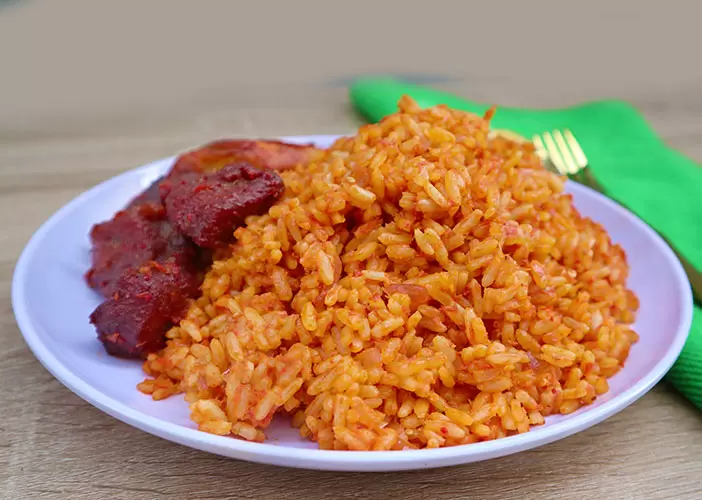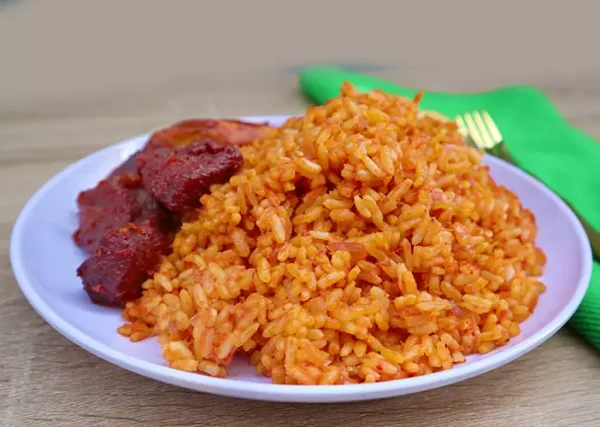Let’s talk about Jollof rice, the superstar of West African cuisine that’s more than just a dish; it’s a cultural sensation. Originally hailing from the Senegambian region, this flavourful treat has won over taste buds far and wide, stirring up friendly competition. Here’s a closer look at what makes Jollof rice special – from its tasty ingredients to the spirited “Jollof Wars.”
Read more about Food
Where It All Began and What Goes In
Jollof rice is a delicious blend of long-grain rice, tomatoes, onions, chillies, and a mix of spices. Some versions add veggies like bell peppers, garlic, and ginger, along with meats like chicken, turkey, beef, or fish. Everything cooks together in one pot, creating a mouthwatering medley of flavours.
Different Strokes for Different Folks
One of the coolest things about Jollof rice is how each West African country puts its spin on it. Nigeria and Ghana are front and centre in the “Jollof Wars,” where folks fiercely defend their recipes. Even French-speaking West Africa has its version, called “riz au gras.” But no matter where you go, Jollof rice is always about coming together to enjoy good food and good company.
The Jollof Wars: A Friendly Rivalry
The rivalry between Naija Jollof and Ghana Jollof is more than just food, it’s more like a cultural phenomenon. It has inspired songs, memes, and even playful arguments. For some people, sticking to tradition is a big deal when it comes to Jollof rice. They get pretty passionate about keeping things authentic and might not be too happy about new ingredients sneaking in. But everyone has their style, and experimenting with flavours is part of the joy of cooking.
Sign up for the Connect Nigeria daily newsletter
How Naija Jollof Is Done
Making Naija jollof rice can sound complicated, but it’s not too hard once you get the hang of it. Here’s what you need:
- Long-grain rice (like golden sella basmati rice)
- Tomatoes or tomato paste
- Onions
- Peppers (like chilli, scotch bonnet, and bell pepper)
- Vegetable oil
- Meat broth or stock
- Some extra spices like thyme, bay leaves, curry powder, white pepper, nutmeg, and stock cubes
You can use different kinds of rice, but it’s best if it’s parboiled, which means it’s partially boiled before it’s packed. It helps the rice stay firm and not get too mushy when you cook it all together in one pot.
When you’re ready to cook, you start by frying up a mixture of tomatoes and peppers until it’s all nice and thick. Then, you add the rice and let it soak up all the yummy flavours from the tomato mixture and meat broth as it cooks.
Once it’s all done, you can serve your jollof rice with your favourite protein, like beef, turkey, chicken, or fish. And don’t forget the side dishes! Fried plantains, steamed veggies, or salad all go great with it. You can make it your own with whatever you like best.
Making Jollof rice might have different steps depending on who’s cooking, but the basics are pretty simple. You start by frying up tomatoes, onions, and spices to make a tasty base, then you let the rice soak up all that deliciousness as it cooks. It’s usually served with a protein like chicken or fish, plus some fried plantains, veggies, or salad on the side for a well-rounded meal.
Register to attend the CN Business Mixer
Final Thoughts
Jollof rice is more than just food. Its mouthwatering flavours reflect the diversity of the continent, while the playful “Jollof Wars” show just how much people love it. Whether you’re enjoying it in Nigeria, Ghana, or anywhere else, one thing’s for sure, Jollof rice will always have a special place in the hearts and stomachs of those who savour its deliciousness.
Got a suggestion? Contact us: [email protected]


